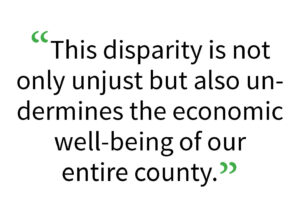It’s essential all stakeholders engage in a thoughtful and nuanced dialogue
![]()
This editorial is the opinion of Morgan Hill Life

The recently released vendor disparity study in Santa Clara County offers an important opportunity to look at the role of race in public contracting. The MGT consulting group’s findings reveal a significant underrepresentation of minority-owned businesses in the county’s contracts. This leads some to call for targeted programs and set-asides to address the disparity. However, others argue that such race-based solutions are misguided and counterproductive.
 The study reveals that between July 2016 and June 2021 a mere 15 percent ($364 million) of the county’s $2.4 billion in public contracts were awarded to minority-owned businesses. It is particularly alarming that less than 1 percent of the total contract value was spent on businesses owned by Black, Hispanic, or Native American individuals.
The study reveals that between July 2016 and June 2021 a mere 15 percent ($364 million) of the county’s $2.4 billion in public contracts were awarded to minority-owned businesses. It is particularly alarming that less than 1 percent of the total contract value was spent on businesses owned by Black, Hispanic, or Native American individuals.
This disparity is not only unjust but also undermines the economic well-being of our entire county. When local, minority-owned businesses are excluded from the contracting process, it perpetuates systemic inequalities and hinders the growth of our communities. The data indicates the county has failed to provide equal opportunities to its diverse business community.
Proponents of targeted programs argue they are necessary to level the playing field and ensure that all businesses have a fair chance to compete. Furthermore, the county has a responsibility to ensure its procurement process is transparent, fair, and inclusive. This may require taking proactive steps to engage with minority-owned businesses, provide training and resources, and remove barriers to entry.
On the other hand, critics argue that race-based preferences and set-asides are inherently unfair and undermine the principles of equal opportunity and individual achievement. They contend that the focus should be on creating a competitive bidding process that rewards businesses based on their merits, not the color of their owners’ skin.
Moreover, there are concerns that race-based programs may not effectively address the root causes of disparities in public contracting. Instead, they argue, the county should focus on removing barriers to entry, streamlining the bidding process, and providing resources and training to all small businesses, regardless of the racial or ethnic background of their owners.
 Let’s note the study’s findings alone do not necessarily prove the existence of systemic racism in the county’s contracting process. There may be a variety of factors contributing to the disparity, such as differences in the size, experience, and qualifications of minority-owned businesses compared to their non-minority counterparts.
Let’s note the study’s findings alone do not necessarily prove the existence of systemic racism in the county’s contracting process. There may be a variety of factors contributing to the disparity, such as differences in the size, experience, and qualifications of minority-owned businesses compared to their non-minority counterparts.
Santa Clara County prides itself on being a progressive and inclusive region. But the study’s findings paint a different picture. It is not enough to simply talk about diversity and inclusion. The county must take concrete steps to address these disparities and create a level playing field for all businesses.
The county should start by implementing targeted programs that encourage and support the participation of minority-owned businesses in the contracting process. This can include providing training and resources to help these businesses navigate the complexities of bidding for public contracts, as well as setting aside a portion of contracts specifically for minority-owned enterprises.
Santa Clara County has an opportunity to lead by example and demonstrate its commitment to equity and inclusion. We encourage Supervisor Sylvia Arenas, who represents South Valley, to be more proactive in pursuing this goal. By taking decisive action to support minority-owned businesses, the county can foster economic growth, create jobs, and build stronger, more resilient communities — and especially so in Gilroy with nearly 60 percent Latinos in its population.
Ultimately, the goal should be to create a level playing field where all businesses have an equal opportunity to compete for public contracts based on their merits. This may require a combination of targeted outreach, technical assistance, and reforms to the contracting process to ensure that it is fair, transparent, and inclusive.
As Santa Clara County grapples with this complex issue, it is essential that all stakeholders engage in a thoughtful and nuanced dialogue. The county should carefully consider the study’s findings, listen to the concerns of the business community, and develop a comprehensive strategy that balances the need for equity with the principles of fairness and equal opportunity. Only by working together can we build a more just and prosperous community for all.






